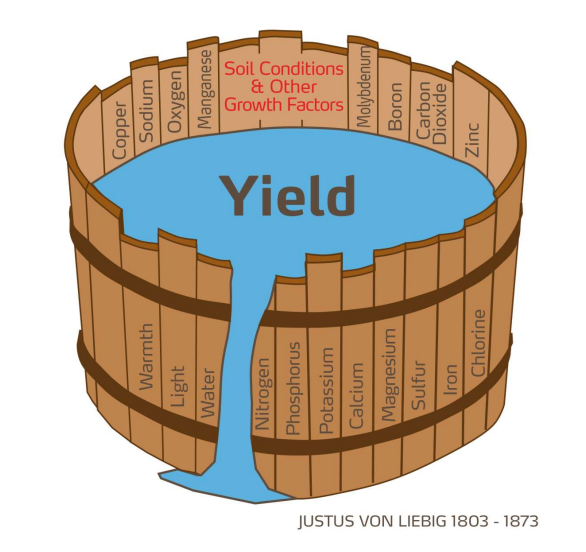Sustainable Nutrient Management: Introduction to Concept, Strategies, and Principles

This post is also available in:
This post is also available in:
![]() Français (French)
Français (French) ![]() Deutsch (German)
Deutsch (German) ![]() العربية (Arabic)
العربية (Arabic) ![]() 简体中文 (Chinese (Simplified))
简体中文 (Chinese (Simplified)) ![]() Português (Portuguese (Brazil))
Português (Portuguese (Brazil))
Sustainable nutrient management: Essential for farmers, consumers, environment, and climate
Wastage of nutrients (Nitrogen and Phosphorus) often damages the environment, has a high economic cost, and causes crop nutrition problems, often damaging crops (yields, quality, and resilience). Lower yields mean more land is needed for cultivation to cover the increased product demand and less space for nature, pastures, forestry, and people. Food wastage, and nutrient loss in livestock production, may reduce for some and increase for others, but the world population and its buying power are still increasing. Both commercial and traditional nutrient management methods can either cause high emissions of greenhouse gases or add value to renewable energy, trees, and other plants, capturing more carbon (and sometimes Nitrogen) and storing it or replacing fossil fuels. Up-to-date knowledge is essential – but conflicting, oversimplified views are widespread and divisive.
Is sustainable plant nutrient management (SPNM) the same as integrated nutrient management?
The sustainability of plant nutrient management and related terms are much debated, and many feel satisfied with oversimplified common assumptions, views, and myths. The sustainable (plant) nutrient management term will here be used as a broad goal and topic, and no general assumptions of whether commercial, “chemical” fertilizers should be included (as expected in integrated plant nutrient management) or not (as in organic farming). Access to cost-effective fertilizer and nutrient-rich organic manures is a big challenge in some places. Better insight is needed at all levels. Sustainable nutrient management is also a priority in regenerative agriculture or farming and in agroecology, which also covers other aspects and are terms defined in many ways.
Practically relevant principles will be in focus in this set of articles on SNM, including advice on getting more data and local observations. The articles can also help as an introduction, reminder, or update to learning more, and more learning will be needed. Soil fertility was also focused on Wikifarmer Library articles on soil and water conservation by Mandal (2022). Nutrient uptake and their effective use are also crucial for the nutrition of plants, humans, and livestock.

Figure 2. Harvest and erosion can remove many nutrients and recycling all harvested can be hard. Red or sandy soils often contain few reserves to deplete and long fallow periods are rarely possible today.
Important strategies and terms for sustainable plant nutrient management include:
- Obtain a high Nutrient Use Efficiency (NUE, the fraction of harvested supplies). That requires insight and many good practices and principles – not only for soil fertility but also for plants’ capacity to take up nutrients and use them in symbiosis with bacteria and fungi.
- Reduce losses to the environment from leaching below the root zone by water or air (volatilization) due to erosion. This can be combined with building or conserving surface cover and organic matter. See nine articles on soil and water conservation focus at Wikifarmer Library by Mandal (2022).
- Replacing nutrients removed from the field (at least when needed). Some nutrients may be deficient from the start, at least in biologically available forms. In contrast, others may have available reserves in the field for centuries or even in excess (toxic) levels. In poor tropical areas, soil fertility and even the total nutrient content are often too low, and so is the capacity to frequently find, buy, or transport enough manure or fertilizer. Biological activities can help make some plant nutrients available, but some soils are even deficient in total nutrients, including unavailable plant nutrients, locked inside small, hard stones. Some soil types important in the humid tropics have lost the minerals that could release nutrients (dark or shiny weatherable minerals). This is particularly the case for very old, leached, reddish soil types named Oxisols by USDA or Ferralsols by FAO/UNESCO mainly. Some nutrients may not be relevant to replace, like the micronutrient iron, where the uptake in non-acid soils rather than the soil content is challenging. However, they may, e.g., hold (fix) some phosphate in forms that slowly can be released in very low concentrations. Some plants and symbiotic (“collaborating”) bacteria and root fungi benefit the process. See Figure 2.
- Know and supply limiting nutrient(s). These nutrients prevent increased crop yields, but if one is supplied (especially in large quantities), another may be restricted sooner or later. Yields may be reduced if a nutrient deficiency is visible in many plants of our crop. Water can also be a limiting growth factor. Inside greenhouses with otherwise optimal conditions, CO2 can sometimes be the limitation to growth. However, this is rarely the case in open fields with other limitations than CO2, and with plants that during much of the season are either small or ripening. Essential nutrients are necessary for plants, nitrogen fixation, and/or animals but are often sufficiently available. Some of these are rarely limiting. Other beneficial micronutrients may benefit some plants, nitrogen-fixing bacteria, or animals. Excess of nutrients (beyond the adequate and optimal level) can be harmful; this can be due to toxicity or competition with other nutrient ions with a similar charge. The principle of Liebig’s law of the limiting or minimum growth factor is shown in Figure 3.

Figure 3. Liebig’s law of the limiting plant growth factor shows the deficient (minimum) factor(s) need to be addressed first. Credit: Yara Fertilizer Industry Handbook (2022).
Related strategies exist.
- Conservation farming or agriculture focuses on reduced or no tillage and emphasizes loosening compacted subsoils first, reduced or no tillage, cover crops, and sometimes agroforestry, etc. The use of fertilizer and pesticides varies, but herbicides are often used. In southern Africa, nitrogen-fixing trees have, in recent years, been included as a vital part of conservation agriculture after fertilizer prices increased.
- Regenerative farming has a similar focus but is broader in its definition, like agroecology but with less focus on socioeconomics.
- Organic farming includes several similar aims and methods. However, their restriction on the use of water-soluble fertilizers makes it debated in which cases and scales it is sustainable for plant nutrition or not.
Agroecology and other overlapping concepts are also important and discussed in another overview article by Mandal (2023) at Wikifarmer Library on plant nutrition. Central for agroecology are efficiency and resilience via recycling, synergy and diversity (e.g., using agroforestry, crop rotation and intercropping) combined with socioeconomic factors to support small-scale farmers and traditional food supplies.
In short, sustainable nutrient management requires efficient use of nutrients based on applying what is available, needed, and can be taken up by the plants and minimizing losses. Depending on the situation, this may be done with or without using the so-called “chemical” fertilizers, but the combination of many soil fertility methods should be considered. Some nutrient levels may have to increase, and others may decrease for some time. Organic matter, pH, salts, soil biology, and conservation should also be managed sustainably. Various strategies and principles exist to help succeed in these goals.
References:
FAO (2018): The 10 Elements of Agroecology. 10 elements | Agroecology Knowledge Hub | Food and Agriculture Organization of the United Nations (fao.org)
Fertilizer Industry Handbook 2022 (yara.com)
Mucheru-Muna M, Mugende D, Pypers P, Mugwe J, Kung’u J, Vanlauwe B, Merckx R. (2014): Enhancing maize productivity and profitability using organic inputs and mineral fertilizer in central Kenya small-holder farms. Experimental Agriculture, 50(2), 250-269. Doi:10.1017/S0014479713000525
Mudombi-Rusinamhodzi G and Rusinamhodzi L (2022): Food sovereignty in sub-Saharan Africa: Reality, relevance, and practicality. Front. Agron. 4:957011. doi: 10.3389/fagro.2022.957011.
See also references in the detailed articles on soil fertility here at Wikifarmer Library
Sustainable Plant Nutrient Management (SPNM): An overview
Sustainable Nutrient management: Introduction to concept, strategies, and principles
Nutrient conservation and cycling
Mineral fertilizers (including ash) and sustainability
Biological Nitrogen Fixation and seeding Legumes for Soil Fertility
The importance and management of Phosphorus (P) and Potassium (K) in plant production
Ion charges and secondary (=meso) nutrients: Calcium, Magnesium and Sulphur
How important are the Micronutrients for plants
Soil and plant analysis and field observations
When are approaches to Plant Nutrient Management actually Sustainable?








































































